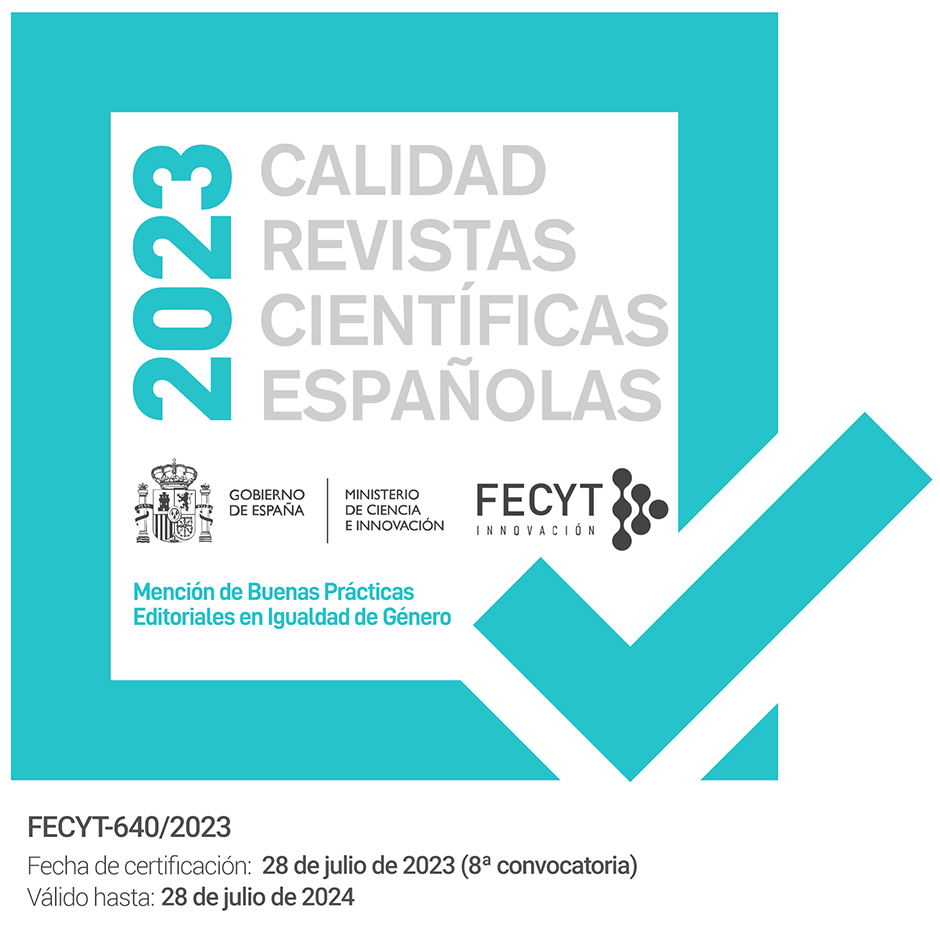Anticholinergic risk profiles, clinical and sociodemographic characteristics in a public nursing home in southern Spain: a descriptive study
DOI:
https://doi.org/10.60103/phc.v26.e839Keywords:
Anticholinergic risk; Nursing home; PolypharmacyAbstract
Objective: to analyze the demographic, clinical and functional characteristics of the elderly in a public nursing home. Characterize the population based on anticholinergic risk according to the Drug Burden Index (DBI) scale.
Methods: It was carried out a descriptive and observational study in a nursing home of the Andalusian public network from September to December 2020. Demographic, clinical, functional and pharmacotherapeutic outcomes were recorded. Drug treatment was analysed using the DBI scale to determine the anticholinergic load. An association analysis was performed among the different variables studied based on the anticholinergic load.
Results: 148 residents were included. 19.8% of the population was illiterate. 43.9% had smoking and 22.3% consumed alcohol daily. 50.3% had excessive polypharmacy (≥10 medications) and 73.6%. of the patients presented anticholinergic and/or sedative risk according to DBI (defined by presenting a DBI score>0). Delirium, anxiety, and recurrent urinary tract infections were more prevalent in the group of residents with anticholinergic load (p<0.05).
Conclusion: the population of the nursing home has a high rate of illiteracy, and a high prevalence of tobacco and alcohol consumption. The rate of polypharmacy, as well as the percentage of patients with anticholinergic risk associated with pharmacotherapy is high. Anxiety, delirium, and recurrent urinary tract infections were more prevalent in the population with anticholinergic burden. Multicenter studies with a larger number of residents would be necessary to confirm these findings.
Downloads
References
Villalba-Moreno AM, Alfaro-Lara EM, Sánchez-Fidalgo S. Fármacos con carga anticolinérgica: aspectos prácticos y precauciones [Internet]. FMC. 2020;27(7):353-67.
Sumukadas D, McMurdo ME, Mangoni AA, Guthrie B. Temporal trends in anticholinergic medication prescription in older people: repeated cross-sectional analysis of population prescribing data. Age and Ageing. 2014;43(4):515-521.https://doi.org/10.1093/ageing/aft199
Algra Y, Haverkort E, Kok W, Etten-Jamaludin FV, Schoot LV, Hollaar V et al. The Association between Malnutrition and Oral Health in Older People: A Systematic Review. Nutrients. 2021;13, 3584. https://doi.org/10.3390/nu13103584
Trenaman ShC, Bowles SK, Kirkland S, Andrew MK. An examination of three prescribing cascades in a cohort of older adults with dementia. BMC Geriatrics. 2021; 21:297. https:// doi: 10.1186/s12877-021-02246-2.
Ailabouni N, Mangin D, Nishtala PS. DEFEAT-polypharmacy: deprescribing anticholinergic and sedative medicines feasibility trial in residential aged care facilities. Int J Clin Pharm 2019 [;41(1):167-178. https://doi.org/10.1007/s11096-019-00784-9.
Villalba-Moreno AM, Alfaro-Lara ER, Pérez-Guerrero MC, Nieto-Martín MD, Santos-Ramos B. Systematic review on the use of anticholinergic scales in poly pathological patients. Arch Gerontol Geriatr. 2016; 62:1-8.
Hilmer SN, Mager DE, Simonsick EM, et al. A Drug Burden Index to Define the Functional Burden of Medications in Older People. Arch Intern Med. 2007; 167(8):781-7. https://doi.org/10.1001/archinte.167.8.781
Villalba-Moreno AM, Alfaro-Lara ER, Rodríguez-Pérez A et al. Association Between Drug Burden Index and Functional and Cognitive Function in Patients with Multimorbidity. Current Pharmaceutical Design. 2018; 24(28): 3384-3391. https://doi.org/10.2174/1381612824666180327154239
Tristancho-Pérez, Á, Villalba-Moreno Á, López-Malo de Molina M.D, Santos-Ramos, B, Sánchez-Fidalgo S. The Predictive Value of Anticholinergic Burden Measures in Relation to Cognitive Impairment in Older Chronic Complex Patients. J. Clin. Med. 2022, 11, 3357. https://doi.org/10.3390/jcm11123357
Abellán García A, Aceituno Nieto P, Fernández Morales I, Ramiro Fariñas D, Pujol Rodríguez R. Envejecimiento en Red [Internet]. Madrid: Blog Envejecimiento [en-red]. CSIC - Instituto de Economía, Geografía y Demografía (IEGD); 2022- [Citado el 06 de abril de 2022]. Disponible en : https://envejecimientoenred.es/una-estimacion-de-la-poblacion-que-vive-en-residencias-de-mayores/.
Villalba-Moreno AM, Galván-Banqueri M, Rodríguez-Pérez A, Toscano-Guzmán MD, López-Hermoso C, Sánchez-Fidalgo S, Santos-Ramos B, Alfaro-Lara ER. Chronic-pharma: New Platform for Chronic Patients Pharmacotherapy Optimization. J Med Syst. 2022 ;46(4):18. https://doi.org/10.1007/s10916-022-01808-0
Villalba-Moreno A, Alfaro-Lara ER, Sánchez-Fidalgo S, Nieto-Martín MD, Santos-Ramos B. Development of the Anticholinergic Burden Calculator Web Tool. Farm Hosp. 2017; 41(5): 647-648.
McKhann GM, Knopman DS, Chertkow H, Hyman BT, Jack CR, Kawas CH et al. The diagnosis of dementia due to Alzheimer´s disease recommendations from the National Institute of Aging and the Alzheimer´s Association workgroup. Alzheimers Dement 2011; 7:263-9. https://doi.org/0.1016/j.jalz.2011.03.005
Charlson ME, Pompei P, Ales KL, MacKenzie CR.: A new method of classifying prognostic comorbidity in longitudinal studies: development and validation. J Chronic Dis. 1987; 40(5): 373-383. https://doi.org. 10.1016/0021-9681(87)90171-8
Mahoney Fi, Barthel Dw. functional evaluation: the barthel index. Md State Med J. 1965; 14:61-5
The Modification of Diet in Renal Disease Study: design, methods, and results from the feasibility study. Am J Kidney Dis. 1992 Jul;20(1):18-33. doi: 10.1016/s0272-6386(12)80313-1. PMID: 1621675.
Levey AS, Eckardt KU, Tsukamoto Y, Levin A, Coresh J, Rossert J et al. Definition and classification of chronic kidney disease: a position statement from Kidney Disease: Improving Global Outcomes (KDIGO). Kidney Int. 2005; 67:2089-100. https://doi.org/10.1111/j.1523-1755.2005.00365.x
Pérez Díaz J, Ramiro Fariñas D, Aceituno Nieto P, Muñoz Díaz C, Bueno López C, Ruiz-Santacruz JS et al. “Un perfil de las personas mayores en España, 2022. Indicadores estadísticos básicos” [Internet]. Madrid: Envejecimiento en Red. Departamento de Población del Consejo Superior de Investigaciones Científicas (CSIC); 2022 [Consultado 4 Marzo 2023]. Informes Envejecimiento en red nº 29; 2022. Disponible en: http://envejecimiento.csic.es/documentos/documentos/enred-indicadoresbasicos2022.pdf
Huesa Andrade M, Calvo-Gallego JL, Pedregal-González MA, Bohórquez Colombo P. Diferencias entre pacientes institucionalizados y pacientes en atención domiciliaria en la provincia de Sevilla. Aten Primaria. 2020. 52(7): 488-495. https://doi.org/10.1016/j.aprim.2019.10.002
Pérez Díaz J, Abellán García A, Aceituno Nieto P, Ramiro Fariñas D. (2020). “Un perfil de las personas mayores en España, 2020. Indicadores estadísticos básicos” [Internet]. Madrid: Envejecimiento en Red. Departamento de Población del Consejo Superior de Investigaciones Científicas (CSIC);2020 [Consultado 10 noviembre 2022]. Informes de envejecimiento en red nº 25; 2020. Disponible en: http://envejecimiento.csic.es/documentos/documentos/enred-indicadoresbasicos2020.pdf>
INE Encuesta Nacional de Salud, 2017 [Internet]. Madrid: Instituto Español de estadística; 2018 [Consultado 20 de diciembre 2022]. Disponible en: https://www.ine.es/dyngs/INEbase/es/operacion.htm?c=Estadistica_C&cid=1254736176783&menu=resultados&idp=1254735573175
INE Encuesta Europea de Salud en España (EESE) 2020 [Internet]. Instituto Nacional de Estadística; 2021 [Consultado el 20 de diciembre de 2022]. Disponible en: https://www.ine.es/dyngs/INEbase/es/operacion.htm?c=Estadistica_C&cid=1254736176784&menu=resultados&idp=1254735573175
Soriano JB et al. Prevalence and Determinants of COPD in Spain: EPISCAN II. Arch Bronconeumol. 2021;57(1):61-69. https://doi.org/10.1016/j.arbres.2020.07.024
Cano-Portero R, Amillategui-dos Santos R, Boix-Martínez R, Larrauri-Cámara A. Epidemiología de la tuberculosis en España. Resultados obtenidos por la Red Nacional de Vigilancia Epidemiológica en el año 2015. Enferm Infecc Microbiol Clin. 2017;36(3): 179-186. https://doi.org/ 10.1016/j.eimc.2017.11.013
Simou E, Britton J, Leonardi-Bee J. Alcohol consumption and risk of tuberculosis: a systematic review and meta-analysis. Int J Tuberc Lung Dis. 2018;22(11):1277-1285. https://doi.org/10.5588/ijtld.18.0092. PMID: 30355406.
Pazan F, Wheling M. Polypharmacy in older adults: a narrative review of definitions, epidemiology and consequences. European Geriatric Medicine. 2021; 12:443–452. https://doi.org10.1007/s41999-021-00479-3https://doi.org10.1007/s41999-021-00479-3
Cadenas R, Diez MJ, Fernández N, García JJ, Sahagún AM, Sierra M et al. Prevalence and Associated Factors of Polypharmacy in Nursing Home Residents: A Cross-Sectional Study. Int. J. Environ. Res. Public Health. 2021; 18, 2037. https://doi.org/10.3390/ ijerph18042037
Ferro Uriguen A, Laso Lucas E, Sannino Menicucci C, Iturrioz Arrechea I, Alaba Trueba J, Echevarría Orella E et al. Psychotropic Drug Prescription in Nursing Homes During the COVID-19 Pandemic. Drugs Aging. 2022;39(6):467-475. https://doi.org/10.1007/s40266-022-00948-9
Campitelli MA, Bronskill SE, Maclagan LC, Harris DA, Cotton CA, Tadrous M et al. Comparison of Medication Prescribing Before and After the COVID-19 Pandemic Among Nursing Home Residents in Ontario, Canada. JAMA Netw Open. 2021;4(8): e2118441. https://doi.org/10.1001/jamanetworkopen.2021.18441.
Tsubouchi K, Arima H, Abe M, Matsuzaki H, Tominaga K, Fujikawa A et al. Effect of Pharmacotherapy for Overactive Bladder on the Incidence of and Factors Related to Urinary Tract Infection: A Systematic Review and Meta-analysis. J Urol. 2023;209(4):665-674. https://doi.org/10.1097/JU.0000000000003209.
Downloads
Published
How to Cite
Issue
Section
License
Copyright (c) 2024 Elena Prado-Mel, Héctor Rodríguez-Ramallo, Ángela María Villalba-Moreno, Emilio García Cabrera , Susana Sánchez Fidalgo

This work is licensed under a Creative Commons Attribution-NonCommercial-ShareAlike 4.0 International License.
La revista Pharmaceutical Care España se publica bajo una licencia «Creative Commons, Reconocimiento, No Comercial y Compartir Igual 4.0 Internacional» (CC BY-NC-SA 4.0)», que permite a otros compartir el trabajo con un reconocimiento de la autoría del trabajo y la publicación inicial en esta revista (con excepción de los usos comerciales).
Los autores que publican en esta revista están de acuerdo con los siguientes términos:a) Los autores conservan los derechos de autor (derechos morales) y garantizan a la revista el derecho de ser el primer soporte documental publicado del trabajo.
b) Se permite y anima a los autores a difundir la versión del trabajo revisado por pares y aceptada para su publicación (por ejemplo, en repositorios institucionales o temáticos), recomendando hacerlo con la versión final del editor “pdf”, “html” o “xml”).








